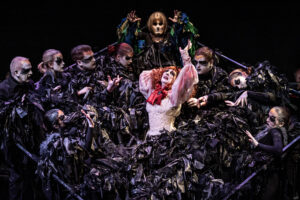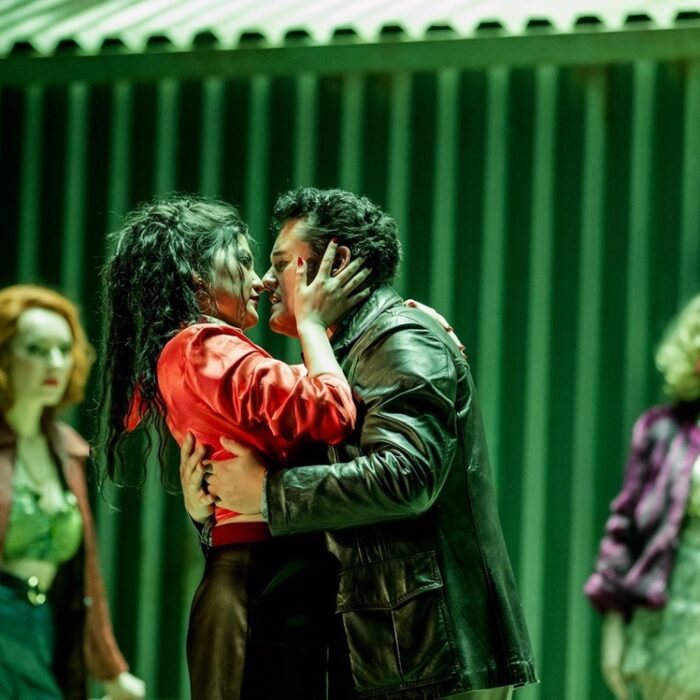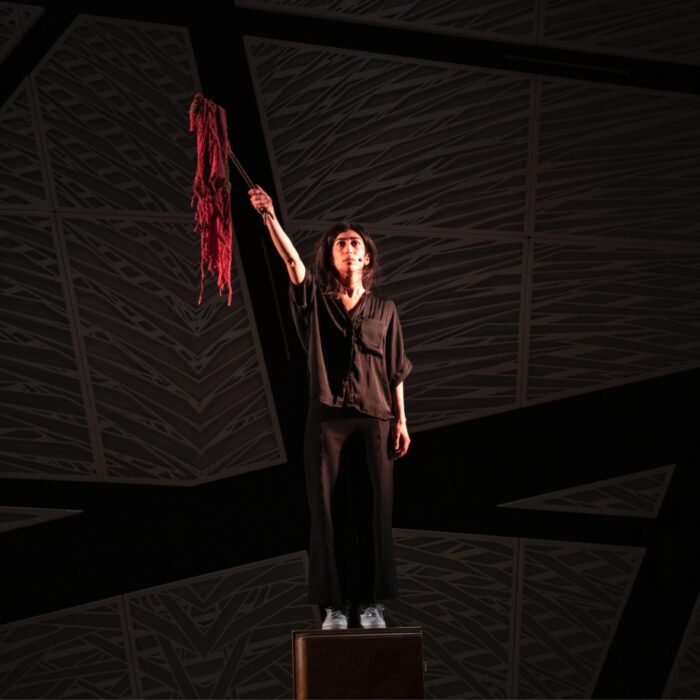
Northern Ireland Opera 2023-24 Review: The Juniper Tree
By Alan NeilsonFairytales have not been kind to stepmothers. Usually depicted as jealous, manipulative and vicious, with a predilection for maltreating, disinheriting and murdering their stepchildren, stepmothers are probably on par with another favorite hate figure of the genre, the wicked witch. A typical example is found in “The Juniper Tree,” taken from Grimms’ Fairytales, published in 1812. This stepmother is not only jealous and vindictive, but discontent with murdering her stepson, she serves up his body in a tasty stew for her husband to enjoy. Rarely, however, do they get away scot free, and unfortunately for this stepmother, she too is destined for her comeuppance. Her daughter buries her half-brother’s bones under the juniper tree, where his mother is also buried, and is transformed into the Juniper Bird, which orchestrates the stepmother’s demise. The son is then resurrected, and they all live happily ever after, although the husband may have been left with a bad taste in his mouth.
It is a marvelous tale, readymade for the theatre, perfect for a family day out. What child could fail to enjoy an afternoon watching a stepmother murder her stepchild and then indulging in a little cannibalism? That, however, is the nature of fairytales. But in the right hands, they do make for great theatre.
Philip Glass and Robert Moran obviously agreed, for in 1985 they wrote an opera based on “The Juniper Tree” to a libretto by Arthur Yorinks. Lasting just over an hour in a single act, it follows the narrative closely without trying to soften the horror. The music is a balanced collaboration, with each composer responsible for approximately half of the score, successfully moulded to create overall coherence. While Glass’ repetitive, urgent rhythms are often used to drive the work forward, Moran’s music tends to be a tad more reflective. Both, however, fashioned their music expertly to promote the narrative and served up wonderful melodic numbers, the most immediately demanding of attention being “Mama killed me, Papa ate me,” which perfectly caught both the horror and fairytale nature of the piece.
A Visually Strong Presentation
Northern Ireland Opera’s artistic director, Cameron Menzies, created a colorful, vibrant staging with plenty of movement that brilliantly captured the thrust of the narrative. Characters and their relationships to each other were clearly drawn, and the confrontation between good and evil was kept central to the production. What really impressed, however, was the way in which Menzies used the set, which he designed, and the costumes, designed by Arlene Riley, to concentrate and sharpen the dramatic impact.
Consisting of no more than a metal frame tilted at an angle towards the audience, criss-crossed by elasticated ropes covered in leaves, the set symbolized the web into which the characters were trapped as well as a representation of the juniper tree. The characters emerged, disappeared and moved between the leaves, while those not directly involved remained outside the frame. The husband, therefore, spends his time outside the web while the horrors that beset his family unfold.
The costumes were Victorian in design but with a gothic twist that combined with the magnificent and colorful hair styles and heavy make-up, designed by Nuala Campbell, to create a group of wired and wonderful characters who, at various times, inhabited the web. Menzies’ lighting designs ensured that they were beautifully illuminated to stand out from the black background against which the story played out.
It all added up as a visually strong representation that gave rise to a number of gripping stage pictures that captured the full impact of the drama, such as when the stepmother is swallowed up by the branches of the juniper tree or when she pursues the Boy under and over its leaves.
Enthusiastic Cast Bring the Tale to Life
The roles were parted by members from the company’s Young Artist Programs, the only exception being the Wife, who was played by soprano Mary McCabe. She possesses a clear voice with a pleasing timbre and rich vibrato and produced a strong, expansive vocal characterization.
James Cooper as the Husband produced a correct but largely unambitious performance and would have benefited from taking a few risks in order to add depth and interest to his character, although, to be fair to Cooper, the role is fairly passive.
Soprano Rachael Heater, dressed in a sailor’s suit, typical of the period, played the role of the Son and later in his manifestation as the Juniper Bird, in which she was perched at the top of the frame-cum-tree, her arms covered in leaves or possibly feathers. She successfully differentiated the two parts of the role: the Boy was open, childlike and naïve, while the Juniper Bird was cold and focused.
Mezzo-soprano Jenny Bourke was a suitably nasty, vicious Stepmother, and she made her hatred for the Boy very clear with an expressively strong vocal presentation to which she added a venomous veneer. She displayed a pleasing middle register and was able to move the voice well, taking in leaps and accenting the vocal line convincingly. Although, at times, she sounded strained when pushing into the upper register, the effect added to her characterization by creating the impression of an uncontrolled, unstable mentality. She does, however, need to work on her vibrato, which is too heavy and distracts from her positive qualities.
The daughter was played by soprano Petra Wells, who produced a sympathetic reading in which her clear-toned, fresh delivery impressed.
The other members, which included basses Paul McQuillan and Ryan Garnham as the Goldsmith and the Cobbler, tenor Desmond Havlin as the Miller, and soprano Niamh Lavery as Mama Bird, all produced good performances, as did the chorus, which produced an energetic reading and successfully added to the atmosphere of the staging.
The musical director, Frasier Hickland, leading a six-piece ensemble, offered excellent support with a finely balanced reading in which he also captured the work’s underlying darkness. It was also a rhythmically strong performance that generated a strong forward momentum.
Overall, it amounted to a satisfying and entertaining presentation, suitable for the whole family. Its gruesome content, tempered by its happy ending and simple message that good will eventually triumph over evil, is perfect for children, while its consideration of deeper themes of transformation, revenge and redemption kept the adults fully engaged.



